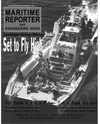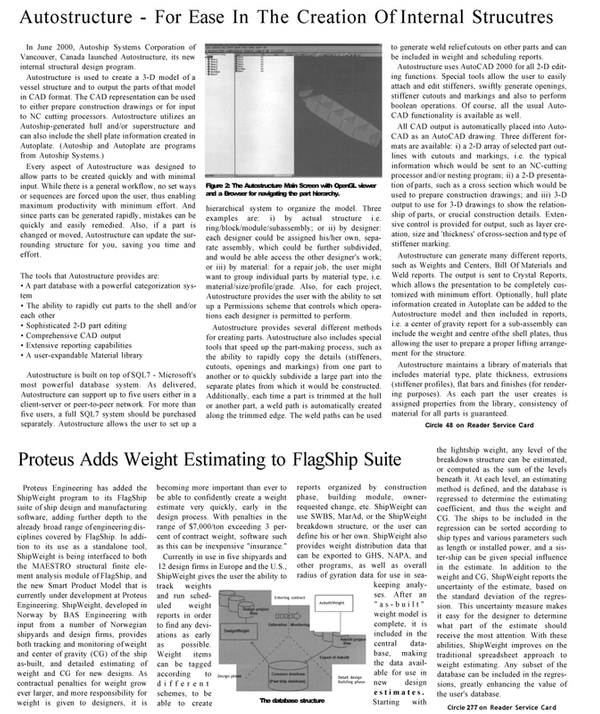
Proteus Adds Weight Estimating to FlagShip Suite
Proteus Engineering has added the ShipWeight program to its FlagShip suite of ship design and manufacturing software, adding further depth to the already broad range of engineering disciplines covered by FlagShip. In addition to its use as a standalone tool, ShipWeight is being interfaced to both the MAESTRO structural finite element analysis module of FlagShip, and the new Smart Product Model that is currently under development at Proteus Engineering. ShipWeight, developed in Norway by BAS Engineering with input from a number of Norwegian shipyards and design firms, provides both tracking and monitoring of weight and center of gravity (CG) of the ship as-built, and detailed estimating of weight and CG for new designs. As contractual penalties for weight grow ever larger, and more responsibility for weight is given to designers, it is becoming more important than ever to be able to confidently create a weight estimate very quickly, early in the design process. With penalties in the range of $7,000/ton exceeding 3 percent of contract weight, software such as this can be inexpensive "insurance." Currently in use in five shipyards and 12 design firms in Europe and the U.S., ShipWeight gives the user the ability to track weights and run scheduled weight reports in order to find any deviations as early as possible.
Weight items can be tagged according to d i f f e r e n t schemes, to be able to create reports organized by construction phase, building module, ownerrequested change, etc. ShipWeight can use SWBS, MarAd, or the ShipWeight breakdown structure, or the user can define his or her own. ShipWeight also provides weight distribution data that can be exported to GHS, NAPA, and other programs, as well as overall radius of gyration data for use in seakeeping analyses.
After an " a s - b u i l t " weight model is complete, it is included in the central database, making the data available for use in new design e s t i m a t e s .
Starting with the lightship weight, any level of the breakdown structure can be estimated, or computed as the sum of the levels beneath it. At each level, an estimating method is defined, and the database is regressed to determine the estimating coefficient, and thus the weight and CG. The ships to be included in the regression can be sorted according to ship types and various parameters such as length or installed power, and a sister- ship can be given special influence in the estimate. In addition to the weight and CG, ShipWeight reports the uncertainty of the estimate, based on the standard deviation of the regression.
This uncertainty measure makes it easy for the designer to determine what part of the estimate should receive the most attention. With these abilities, ShipWeight improves on the traditional spreadsheet approach to weight estimating. Any subset of the database can be included in the regressions, greatly enhancing the value of the user's database.
Circle 277 on Reader Service Card
Read Proteus Adds Weight Estimating to FlagShip Suite in Pdf, Flash or Html5 edition of January 2001 Maritime Reporter
Other stories from January 2001 issue
Content
- Innovation on the Irish Sea page: 8
- Genoese Regeneration page: 8
- Coast Guard Announces Marine Casually Reporting Requirements page: 9
- $29.9M Approved For U.S. Shipbuilding Loan Guarantees page: 9
- Southern Hospitality page: 10
- Incat Signs Deal With Bollinger page: 10
- Image Marine Delivers Cruise Catamaran for Private Operation page: 14
- Spain Creates Joint European Company page: 15
- Crowley To Acquire MTC page: 15
- Cammell Laird Awaits Costa Crociere Decision page: 16
- Wartsila Puts More Sulzer RTA84T's On Large Tankers page: 17
- NASSCO Lands $68 Million Continuous Maintenance page: 18
- Northrop Grumman To Acquire Litton Industries For $5.IB page: 20
- Finnlines Consolidates, Announces Appointments page: 21
- Svenska Skum Equipment On New Fireboats page: 22
- Eastern Shipbuilding Delivers Newest OSV page: 23
- Ayton Cross Arrives To Boost Wijsmuller Marine's Fleet page: 24
- USS Roosevelt Is Commissioned At Mayport page: 24
- Blount-Barker Shipbuilding Formed page: 26
- New N.C. Ferry-Linked Water Monitoring Generates Data page: 28
- Largest Aquastrada High Speed Ferry Under Construction At Rodriquez page: 29
- Passenger Vessel page: 31
- International Appeal With Local Customer Service Feel page: 33
- German Dry Cargo Division Breaks Into Super Yachts page: 35
- 3-D Modeling For Small And Large Vessel Construction page: 36
- Autostructure - For Ease In The Creation Of Internal Strucutres page: 38
- Proteus Adds Weight Estimating to FlagShip Suite page: 38
- Onstream Project To Optimize FPSO Design page: 40
- Napa Oy Introduces NAPA Steel System For Ship Design page: 40
- EnSolve Biosystems1 Senior Scientist Receives Top Honor page: 41
- The Doctor Is "In" page: 42
- The Natural Order page: 44
- Wartsila Fits First "Smokeless" Diesel page: 50
- Aloha Kittiwake - USCG Welcomes Bollinger-Built Patrol Boats page: 51
- 71 Countries Make IMO's Initial STCW White List page: 53
- NORSHIPCO Receives Enviro Honor page: 53
- New Executive Appointments ATROCL page: 54
- SJS Selected To Build Panama Canal Tugs page: 55
- Halter Marine Awarded $69M Option For Car Carrier page: 55
- Alstom Integrated Controls For Clough Offshore page: 56
- Transas Engine Room Simulators Offer Enhanced Capabilities page: 56
- Boatracs Launches VComm IP page: 57
- Litton European Unit Advances IB Concept For Workboats page: 58


